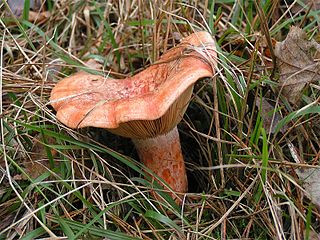
Lactarius deliciosus, commonly known as the delicious milk cap, saffron milk cap and red pine mushroom, is one of the best known members of the large milk-cap genus Lactarius in the order Russulales. It is native to Europe, but has been accidentally introduced to other countries along with pine trees, with which the fungus is symbiotic.

Gymnopilus sapineus, commonly known as the scaly rustgill or common and boring gymnopilus, is a small and widely distributed mushroom which grows in dense clusters on dead conifer wood. It has a rusty orange spore print and a bitter taste. This species does not stain blue and lacks the hallucinogen psilocybin.

Lactarius rufus is a common, medium-sized member of the mushroom genus Lactarius, whose many members are commonly known as milkcaps. Known by the common name of the rufous milkcap, or the red hot milk cap in North America. It is dark brick red in color, and grows with pine or birch trees.

Leucoagaricus leucothites, commonly known as the smooth parasol, woman on motorcycle, ma'am on motorcycle, white dapperling, or white agaricus mushroom, is a species of agaric fungus. The species was originally described as Agaricus leucothites by Carlo Vittadini in 1835, and bears similarity to species of that genus. Solomon Wasser transferred it to Leucoagaricus in 1977. While sometimes regarded as edible, the species is suspected of being poisonous due to gastric-upset-causing toxins. It could also be confused with the deadly Amanita ocreata.
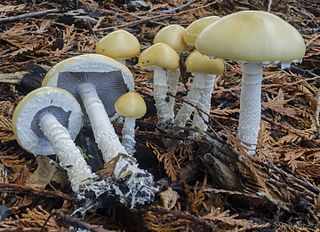
Stropharia ambigua, sometimes known as the questionable Stropharia, is a saprotrophic agaric mushroom, commonly fruiting in leaf litter and wood chips in the Pacific Northwest.

Hydnellum aurantiacum is an inedible fungus, commonly known as the orange spine or orange Hydnellum for its reddish orange or rusty red colored fruit bodies. Like other tooth fungi, it bears a layer of spines rather than gills on the underside of the cap. Due to substantial declines in sightings, this species is listed as critically endangered in the United Kingdom.

Russula fragilis, commonly known as the fragile russula, or fragile brittlegill, is a species of mushroom of the genus Russula, whose members are commonly known as brittlegills. It is a small, fragile, long stemmed, and variably coloured brittlegill, found in mixed forests, and woods in Europe, Asia, and North America.

Gymnopilus ventricosus, commonly known as the jumbo gym, is a species of mushroom in the family Hymenogastraceae. It was first described from the Stanford University campus by Franklin Sumner Earle as Pholiota ventricosa in 1902.

Pholiota malicola, commonly known as the forgettable pholiota, is an inedible species of fungus in the mushroom family Strophariaceae. Originally called Flammula malicola by mycologist Calvin Henry Kauffman in 1926, it was transferred to the genus Pholiota by Alexander H. Smith in 1934. It is found in North America and Australia.

Hygrophorus subalpinus, commonly known as the subalpine waxycap, is a species of white snowbank fungus in the family Hygrophoraceae. Found in the mountains of western North America, it is found growing on the ground under conifers, usually near snowbanks.

Pholiota flammans, commonly known as the yellow pholiota, the flaming Pholiota, or the flame scalecap, is a basidiomycete agaric mushroom of the genus Pholiota. Its fruit body is golden-yellow in color throughout, while its cap and stem are covered in sharp scales. As it is a saprobic fungus, the fruit bodies typically appear in clusters on the stumps of dead coniferous trees. P. flammans is distributed throughout Europe, North America, and Asia in boreal and temperate regions. Its edibility has not been clarified.

Tricholoma saponaceum, also known as the soap-scented toadstool, soapy tricholoma, soapy knight or soap tricholoma is an inedible mushroom found in woodlands in Europe and North America.
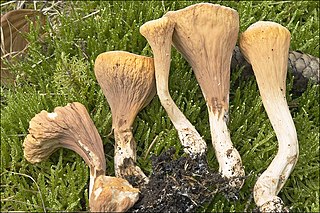
Clavariadelphus truncatus is a species of mushroom. The common name of the species is truncated club or club coral. It is a member of the basidiomycete fungi family Gomphaceae.

Xeromphalina campanella is a species of mushroom. The common names of the species include the golden trumpet and the bell Omphalina. The genus name Xeromphalina means "little dry navel" and campanella means "bell-shaped", respectively describing the mature and young shapes of the pileus, or cap. The mushroom is also called fuzzy-foot.

Crepidotus mollis, commonly known as the peeling oysterling, soft slipper, jelly crep, or flabby crepidotus, is a species of mushroom. It's edibility is unknown, but it is probably inedible and possibly poisonous.

Suillus tomentosus is a species of mushroom. The common names of the species are blue-staining slippery Jack, poor man's slippery Jack, and woolly-capped suillus.
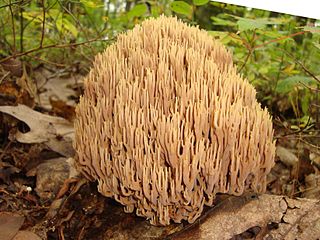
Ramaria stricta, commonly known as the strict-branch coral is a coral fungus of the genus Ramaria. It has a cosmopolitan distribution, and grows on dead wood, stumps, trunks, and branches of both deciduous and coniferous trees. Its fruit body is up to 10 cm tall, made of multiple slender, compact, and vertical parallel branches. Its color is typically light tan to vinaceous-brown. All parts of the mushroom will bruise when handled. There are several lookalike corals that can usually be distinguished from R. stricta by differences in coloration, bruising reaction, or microscopic features. The fungus is inedible due to its unpleasant odor and bitter taste.

Hygrophorus chrysodon, commonly known as the flaky waxy cap, is a species of fungus in the genus Hygrophorus. It is edible but bland in taste. The species is found throughout the Northern Hemisphere.
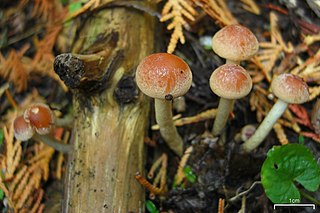
Pholiota astragalina, commonly known as the pinkish-orange pholiota, is a species of fungus in the family Strophariaceae. It was first described scientifically in 1821 by Elias Magnus Fries as a species of Agaricus. Rolf Singer transferred it to the genus Pholiota in 1951. The fruitbodies of the fungus have pinkish-orange caps measuring 2–5.5 cm in diameter. The flesh is orange, blackening in age, with a bitter taste. They produce a reddish-brown spore print, causing it to be placed in its genus rather than Hypholoma, which it resembles. The spores are oval to elliptical, smooth with thin walls, and measure 5–7 by 4–4.5 µm. In North America, the fungus is found in the United States and Canada. In Europe, it has been recorded from France, Sweden, and Switzerland. Its mushrooms usually grow singly or in small clusters, sometimes on conifer logs.

Hygrocybe flavescens, commonly known as the golden waxy cap, is a species of Hygrocybe described from Michigan. It is considered nonpoisonous to humans. The species can be found in various forests and woodlands.




















